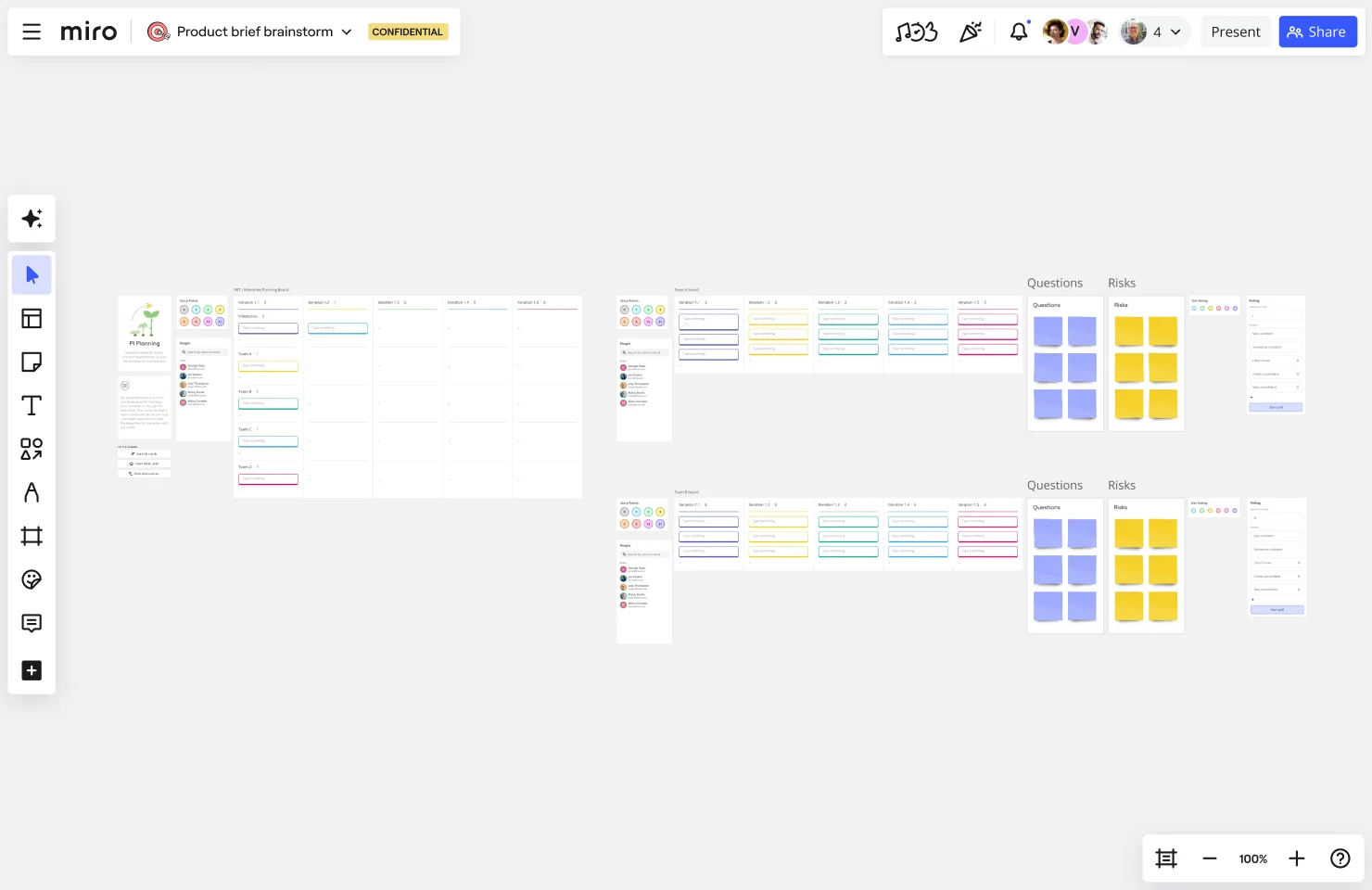
The ultimate guide to big room planning

What is big room planning?
Big Room Planning (BRP) is an Agile collaborative practice that brings together cross-functional teams, stakeholders, and leaders to plan and align work for a set period, often known as Agile Release Planning or a Program Increment, where you use a PI Planning tool. This structured event fosters transparency, breaks down silos, and ensures all teams are working toward shared objectives.
Big Room Planning plays a key role in Agile workflows and Scaled Agile Framework (SAFe) methodologies, promoting seamless collaboration and setting clear priorities. The main objectives of Big Room Planning are to ensure all teams are on the same page and to create a shared understanding of goals. Expected outcomes include detailed plans for features, user stories, and a clear execution path for the upcoming Program Increment.
Big Room Planning vs. regular planning
In traditional planning, teams often work in isolation, each focusing on their own tasks. Big Room Planning takes a more collaborative approach. It brings together representatives from all Agile teams, product management, and key stakeholders into a shared space (physical or virtual) to plan and coordinate work collectively. This ensures alignment, visibility, and better communication across teams.
Key participants in Big Room Planning
To understand how to do Big Room Planning, it’s important to note who needs to participate. Agile BRP sessions involve several key roles that contribute to the alignment and success of the planning process. Each role helps prioritize strategic objectives and customer needs. Let’s break them down:
1. Agile teams
Agile teams are the backbone of Big Room Planning. They’re responsible for outlining what needs to be done, sharing user stories, and coordinating with other teams on dependencies. Their input shapes the actual work that will be completed.
2. Product owners
Product owners bring the customer’s perspective. They help prioritize features, ensuring that what’s being built aligns with both customer needs and business goals. Their role bridges the gap between team execution and customer value.
3. Scrum Masters
Scrum Masters act as facilitators. They make sure the planning process stays on track, help teams clear roadblocks, and ensure discussions remain focused on achieving the goals set for the Program Increment.
4. Release Train Engineers (RTE)
RTEs play the role of conductor. In SAFe, they oversee coordination across all teams, helping to identify risks, manage dependencies, and ensure that the overall planning process runs smoothly and stays aligned with the program’s objectives.
5. Business stakeholders
Business stakeholders provide the big-picture strategy. They offer input on priorities and help ensure that the work planned during the session supports broader company goals. Their involvement helps connect day-to-day work with long-term business objectives.
When to conduct Big Room Planning?
Big Room Planning typically happens at the start of each Program Increment, which lasts around 8-12 weeks. Many organizations hold these sessions quarterly, aligning with their PI Planning schedule.
By regularly conducting Big Room Planning sessions, teams can collaboratively plan, coordinate efforts, and stay focused on shared goals. This consistent cadence helps organizations stay agile and responsive, ensuring teams remain aligned and productive throughout the product development process.
Benefits of Big Room Planning
Big Room Planning brings several advantages, making it valuable for Agile teams working on complex projects. Let’s take a closer look at the key benefits:
Better team alignment
Big Room Planning helps teams and stakeholders build a shared understanding of goals, priorities, and timelines. This alignment reduces miscommunication and ensures everyone is working toward the same objectives, creating stronger collaboration across the board.
Real-time decision-making
With all teams in one room, issues and decisions can be addressed on the spot. This immediate feedback loop cuts down on delays, allowing teams to solve problems quickly and move forward without waiting for further discussions.
Clear inter-team coordination
Big Room Planning encourages open communication between teams, helping them recognize and discuss dependencies. This proactive coordination prevents bottlenecks, ensuring that no team’s work is blocked by another.
Early risk detection
By discussing plans early on, teams can identify risks and dependencies before they become problems. This early detection allows teams to address potential challenges head-on, minimizing disruptions during the Program Increment.
Why Big Room Planning matters for tech professionals
In the tech industry, where projects can be intricate and require close collaboration, effective planning is important. Big Room Planning provides a practical framework that helps tech teams work together more smoothly and reach their project goals.
Streamlining large-scale projects
Big Room Planning brings tech teams together to tackle large projects in one session. This collective effort helps manage dependencies, keeps everyone aligned, and promotes efficient execution, making it easier to handle fast-paced environments.
Embracing Agile principles and Agile Release Trains (ARTs)
Big Room Planning encourages collaboration and supports iterative development. By leveraging Agile Release Trains (ARTs), multiple teams can effectively work together, consistently deliver value, and improve product quality while speeding up time to market.
Conduct Big Room Planning in Miro
Ready to enhance your Big Room Planning sessions? Miro makes it easy to bring all your teams together, whether in person or remotely. Between our intuitive SAFe tools and intelligent templates (including our PI Planning Template), you’ll be equipped to visualize goals, dependencies, and timelines — and keep teams aligned in minutes.
But why not see for yourself? Sign up for Miro to get started.